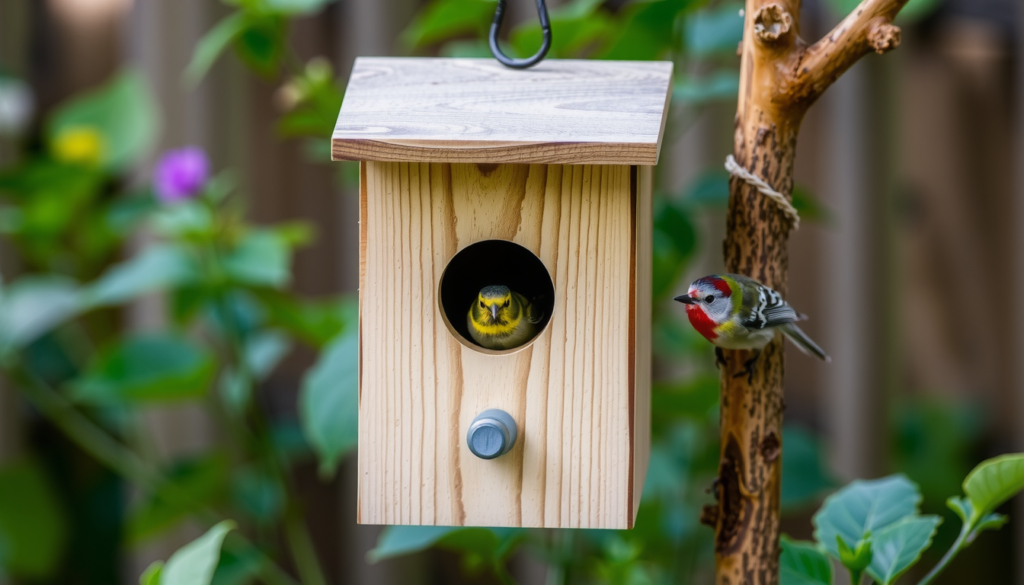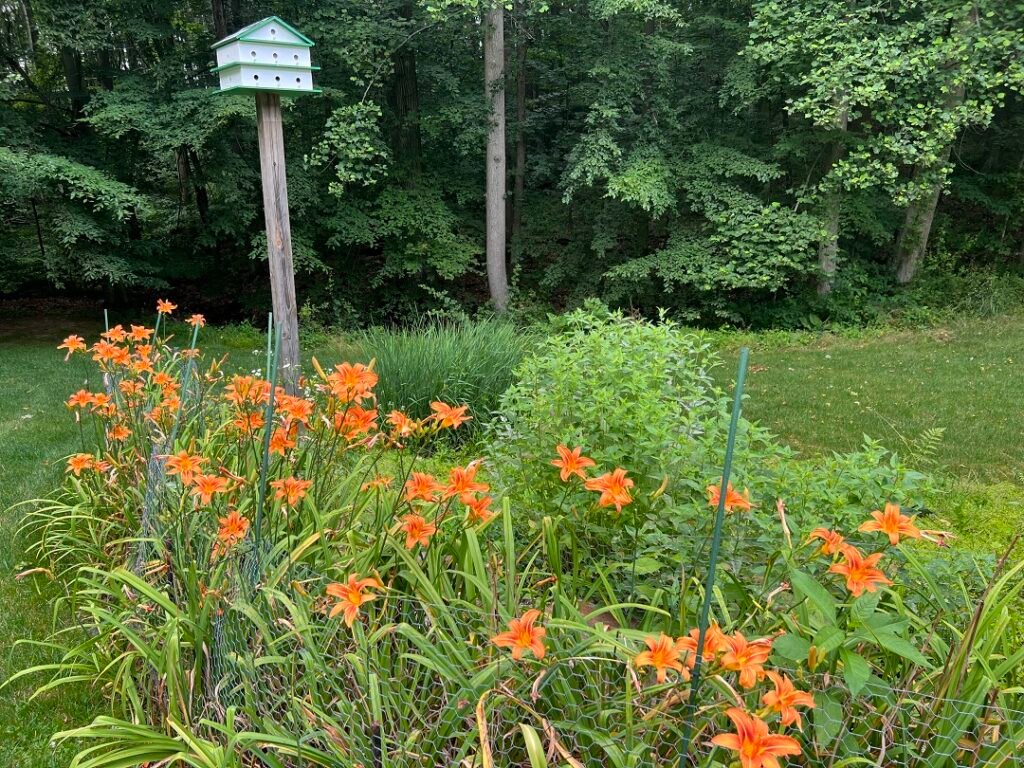Adding a birdhouse is a great way to invite feathered friends into your garden: Selecting the ideal home for local avian species
Adding a birdhouse to your garden can bring new life and joy. It’s a simple way to welcome feathered visitors. Picking the right birdhouse for your local birds is key to making your garden a cozy home for them.

Birdhouses come in many shapes and sizes. Each type fits different birds. Some birds like small holes, while others need more room. Your yard’s trees and plants also matter. They help birds feel safe and comfy. This post contains affiliate links. As an Amazon Associate, I earn from qualifying purchases. This means I may earn a small commission when you purchase through these links, at no additional cost to you. Your support helps maintain this website and provide helpful content.
A good birdhouse can turn your garden into a lively bird haven. You’ll enjoy watching birds make nests and raise their young. It’s fun and helps local bird populations too.
Key Takeaways
- Choose a birdhouse that matches the needs of local bird species
- Place the birdhouse in a safe spot with nearby food and water sources
- Clean and maintain your birdhouse regularly to keep it bird-friendly
Choosing the Right Birdhouse

Picking a suitable birdhouse involves considering the bird species you want to attract and key design features. The right choice can make your garden a welcoming home for feathered visitors.
Bird Species Specifics
Different birds need different homes. Eastern bluebirds prefer open areas with horizontal entrance holes. Carolina chickadees like smaller houses in wooded areas.
Sparrows are less picky and may use various birdhouse types. Check which birds are common in your area. This helps you pick the right house.
Entrance hole size is crucial. It keeps out larger birds and predators. Here’s a quick guide:
- 1 1/8 inch: Chickadees, wrens
- 1 1/4 inch: Bluebirds
- 1 1/2 inch: Tree swallows
Birdhouse Design Considerations
The shape and size of the birdhouse matter. A good design keeps birds safe and comfy. The roof should slope to shed rain. Ventilation holes near the top help control temperature.
Drainage holes in the bottom prevent water buildup. No perches, please! They help predators, not birds. The inside should be rough so baby birds can climb out.
The house should open for easy cleaning. Place it 5-30 feet high, facing away from prevailing winds. Keep it away from feeders to avoid attracting predators.
Material and Durability
Choose materials that last and keep birds safe. Wood is popular and breathable. Cedar, pine, or redwood work well. Avoid pressure-treated wood – it has harmful chemicals.
Paint the outside with light colors to reflect heat. Leave the inside unpainted. Metal can get too hot. Plastic may not breathe well.
Make sure the birdhouse can withstand weather. It should last several nesting seasons. Check for loose parts or sharp edges that could harm birds.
Clean the house each year to prevent parasites. With the right care, your birdhouse will be a cozy home for many feathered families.
Placement and Installation

Proper placement and installation of your birdhouse are key to attracting birds. The right location and setup will keep birds safe and comfortable.
Ideal Locations
Choose spots that birds naturally prefer. Place birdhouses away from busy areas in your yard. Secluded corners or edges of your outdoor space work well.
Aim for spots with some shade and shelter. Near trees or shrubs is often ideal. This gives birds cover and perching spots.
Height is important too. Most birdhouses should be 5-30 feet high, depending on the bird type. Research the right height for your target species.
Face the entrance hole away from prevailing winds. This protects birds from harsh weather.
Installation Tips and Safety
Mount your birdhouse securely. Use sturdy poles, posts, or tree trunks. Make sure it won’t sway or fall in strong winds.
Add a predator guard to the mounting pole. This stops cats and other predators from reaching the nest.
Tilt the house slightly forward. This helps keep rain out and makes it easier for baby birds to exit.
Clean and maintain your birdhouse yearly. Do this in late fall or early spring when birds aren’t nesting.
Attracting and Supporting Bird Life

Creating a bird-friendly space involves providing food, water, and shelter. These elements will help draw a variety of feathered visitors to your yard.
Feeding Essentials
To attract birds, set up bird feeders with a variety of foods. Different species prefer different types of seeds and nutrients.
Popular bird feed options:
- Black oil sunflower seeds
- Nyjer seeds
- Suet cakes
- Mealworms
- Fruit pieces
Place feeders at varying heights to cater to different bird species. Keep feeders clean and filled regularly to maintain a steady food supply for your feathered visitors.
Consider planting native plants that produce berries or seeds. This creates a natural food source and enhances your yard’s bird habitat.
Providing Water
Birds need fresh water for drinking and bathing. A bird bath is an excellent way to supply this vital resource.
Tips for bird baths:
- Place it in a shaded area
- Keep water depth shallow (1-2 inches)
- Change water daily
- Clean regularly to prevent algae growth
You can also install a small fountain or dripper. The sound of moving water is very attractive to birds and can draw them to your yard from a distance.
During winter, consider using a heated bird bath to provide unfrozen water when natural sources are scarce.
Nesting Materials and Features
Offer nesting materials to help birds build their homes. Place small piles of twigs, grass clippings, and pet fur in your yard.
Install birdhouses suited for local species. Research the right size and placement for the birds in your area. Mount houses on poles with predator guards to keep birds safe.
Create brush piles or leave dead tree limbs in place when safe to do so. These provide natural shelter and nesting spots for many bird species.
Plant dense shrubs and trees to offer cover and nesting sites. Native plants are best as they’re adapted to your local climate and wildlife.
Seasonal Care and Maintenance

Proper upkeep of your birdhouse is vital for the health and safety of its feathered residents. Regular cleaning and seasonal adjustments ensure a welcoming habitat year-round.
Cleaning Protocols
Clean your birdhouse thoroughly at least once a year, preferably in late fall or early winter. Remove old nesting material and scrub the interior with a mixture of one part bleach to nine parts water. Rinse well and let it dry completely before rehanging.
Wear gloves and a face mask during cleaning to protect yourself from dust and parasites. Check for any damage or loose parts, and make repairs as needed.
During nesting season, avoid disturbing active nests. Wait until the birds have fledged before cleaning.
Adjusting for Seasonal Changes
In spring, make sure your birdhouse is ready for nesting birds. Check that the entrance hole is clear and the right size for your target species.
Add a thin layer of wood shavings to the bottom of the house to help insulate eggs.
Before winter, remove any perches near the entrance hole. This prevents predators from gaining easy access.
In cold climates, consider adding extra insulation to the roof and walls. You can use natural materials like dry grass or leaves.
During hot summers, ensure proper ventilation by drilling small holes near the top of the birdhouse if they’re not already present.
Creative Birdhouse Ideas

Looking to add a unique touch to your garden? Try these fun birdhouse ideas to attract feathered friends.
A modern birdhouse can be a stylish addition. Choose sleek designs with clean lines and bold colors to complement your outdoor decor.
For a natural look, try a gourd birdhouse. Hollow out a dried gourd and decorate it with non-toxic paint. Birds love these cozy homes that blend into the environment.
Create a bird condo with a multi-level birdhouse. This design offers space for different bird species to nest together. Paint each level a different color for a playful touch.
Get creative with materials. Use old teapots, wooden crates, or even old boots as unique birdhouses. Just make sure they’re properly sealed and have drainage holes.
Involve the whole family in a birdhouse decorating project. Use non-toxic paints, stickers, and natural materials like twigs and pebbles to create one-of-a-kind homes.
Consider the placement of your birdhouses. Hang them at different heights and locations in your garden to attract a variety of bird species.
Remember to clean your birdhouses regularly to keep them safe and inviting for your feathered guests.
Frequently Asked Questions

Choosing and installing the right birdhouse helps attract local birds to your garden. It’s important to consider factors like size, placement, and safety features.
How do I select the appropriate birdhouse for my local bird species?
Pick a birdhouse that matches the needs of birds in your area. Check the entrance hole size to make sure it fits the birds you want to attract.
Research common birds in your region and their nesting habits. This will help you choose the right materials and design.
What are the benefits of installing a birdhouse in my garden?
Birdhouses provide shelter for nesting birds. They can increase the bird population in your yard.
Watching birds can be relaxing and educational. Birdhouses also help with pest control as many birds eat insects.
What type of food should be provided in a birdhouse to attract birds?
Birdhouses are for nesting, not feeding. Don’t put food inside the birdhouse.
Instead, set up bird feeders near the birdhouse. Offer seeds, nuts, and fruits suitable for local bird species.
What are the essential features to look for when choosing a birdhouse?
Look for a sturdy birdhouse with proper ventilation and drainage. The entrance hole should be the right size for your target birds.
Make sure the birdhouse has a sloped roof to keep rain out. It should also have a way to open for easy cleaning.
In what ways do birdhouses assist in bird conservation efforts?
Birdhouses provide safe nesting spots, especially in areas with fewer natural options. This helps maintain and grow bird populations.
They can also be used to study nesting habits and track bird populations. This information helps with conservation planning.
What should be taken into consideration when placing a birdhouse to ensure safety for birds?
Place the birdhouse away from predators. Mount it at the right height for your target bird species.
Face the entrance away from prevailing winds. Make sure there’s some shelter from direct sunlight and rain.






